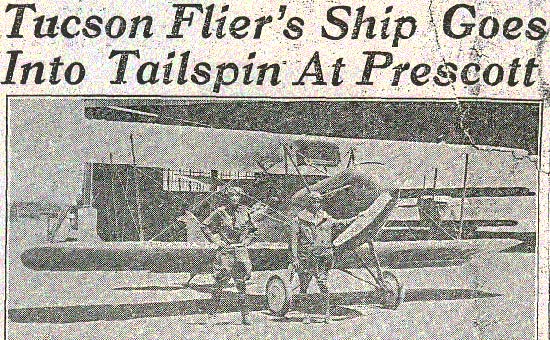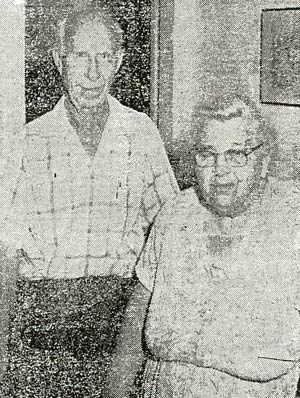|
Gilbert Walmisley Sykes was a local Arizona aviator. He was
a well-known parachute jumper before he learned to fly. His
flying activity was only part of a long and full life.
When he was 11, his father sent him and his brother to school
in England. At the outbreak of WWI, they volunteered for the
British Military. He joined the Royal Flying Corps, but quickly
was transferred to the wireless section of the Royal Navy,
where he was often visited by M.G. Marconi, inventor of the
wireless.
After return to the U.S. in 1919 he went to work for the
U.S. Forest Service as a fire lookout in the Catalina Mountains.
His mark at the Forest Service remains to this day as a nominator
for the largest velvet mesquite tree in the state of Arizona.
He authored two articles for the Forest Service. I have not
read these articles, which appeared in the Service's "Fire
Management Today" publication, but here they are in case
you are interested: Sykes, Gilbert. Mechanical weakness of
the fire swatter. 04(4): 191-192. And Sykes, Gilbert. Coronado
fire camp table. 17(1): 21. Except for a 10-year period (about
1923-33), he was a forest ranger his entire life.
He quit the Forest Service in 1923 and opened the first radio
repair shop in Tucson. He became interested in flying and
paid for his lessons by parachute jumping at air shows. He
took flight lessons at the Davis-Monthan Airfield. His flight
instructor was Charles W.
Mayse.
Sykes and Mayse flew and jumped at local aviation events.
A feature article on Sykes in the Arizona Daily Star, March
25, 1962, reports on one such experience.
"At the 1925 Phoenix air show, Sykes left the
packed chute on the plane and during the night a heavy
dew soaked it through.
"At 3,000 feet Sykes climbed out on the wing and
clung to the struts while he buckled on three straps,
one around his waist and two arond his upper thighs,
grasped an iron hoop holding the chute shrouds and jumped
off.
"'The idea was for the slipstream to inflate the
chute. Only this time it didn't work like that. The
chute was too wet to open up and I fell for about 2,000
feet, jerking and pulling on the lines to open 'er up.
"'Finally at 1,000 feet the chute opened but I
was falling so fast the shock tore the ring out of my
hands and broke the strap around my waist. Then a second
jerk from the chute snapped the strap around one leg
and pulled the other strap down my leg.
"'It was a good thing I was wearing cowboy boots
because the strap caught on my heel and toe and left
me dangling head down. To top it off, that darned Charlie
flew a circle around me as I hung there and yelled,
'What's wrong?'
"'There I was hanging by one leg and he wants
to know what's wrong. I managed to twist around 'til
I got the ring and I landed all right.', he said."
|
The same news feature reports that, about this time, Irene
Lindley came to Tucson from Chicago. She also took flying
lessons from Mayse, and bought Waco 4280
from him. The flying, as well as both owning airedales, brought
Gilbert Sykes and Irene Lindley together and they married
in 1928, the same year Sykes soloed.
The Tucson Citizen reports his first solo flight on April
17, 1928. It reports of Sykes' zeal for aviation, such that,
"...he recently acquired a half section of land nine
miles southwest of Tucson on the Ajo road, which he intends
to make into a private aviation field for his own and his
friends' use." For some reason he did not announce his
solo flight, preferring that his flight, "...this morning
was intended to be secret. Not even his closest companions
were informed that he would make his initial flight as a pilot."
It didn't take long for him to gain "experience".
All totaled, pilot Sykes signed the Davis-Monthan Airfield
Register twice, on May 4, and June 5, 1928. Both times he
was flying the Waco 10, registration number 4280, pictured
in both images below. It is surprising he didn't sign the
Register more often, as he was a "local". He carried
a passenger on June 5th; a Mrs. Huggins. Luckily, she wasn't
with him three days later. The Citizen headline on June 8,
1928 follows.
He wasn't seriously injured, his face taking the cuts and
bruises of the crash. A tough lesson, nevertheless, as his
pilot license was barely two months old, and he did wreck
his wife's airplane.
Below, an image of his crashed airplane about seven miles
north of Prescott on the way to Flagstaff. As a past resident
of Flagstaff, Sykes was on his way there to participate in
the dedication of the Flagstaff Airport (Koch Field). The
airplane was demolished.
Later in June, on the 28th, the evening newspaper reports
Sykes named as head of the Tucson aviation committee. His
first big job was coordination and preparations for the National
Air Tour that was to pass through Tucson on July 10th.
Preparations included dragging and marking the field, selection
of a score or more of officials, securing transportation for
competitors and officials, planning entertainment, publicity
and securing guards and messengers. The 26 competitors in
the 1928 tour were scheduled to leave Detroit on June 29th,
to reach Tucson from El Paso on the morning of July 10 between
10AM and noon, and to remain until the next morning to depart
for the Pacific coast. Sykes had a large responsibility over
the following 12 days!
Gilbert and Irene stayed together many years, and another
feature article in the Arizona Daily Star during the spring
of 1970 included this image of them.
In 1933, he went back to work for the Forest Service. I could
find no other records that mentioned anything about his or
Irene's flying activities or aircraft ownership after that.
He retired from the Forest Service in 1962.
Gilbert W. Sykes passed away on August 23, 1982, of pneumonia,
while vacationing in Penzance, England. He was 82 years old.
He was a lifetime member of the Arizona Cattle Grower's Association
(his father had been, among other things, an early cattle
rancher in Arizona), a member of the Pioneer Historical Society,
and a member of the board of the Arizona-Sonora Desert Museum.
---o0o---
UPLOADED: 01/23/06 REVISED: 10/07/07, 06/11/23
|




